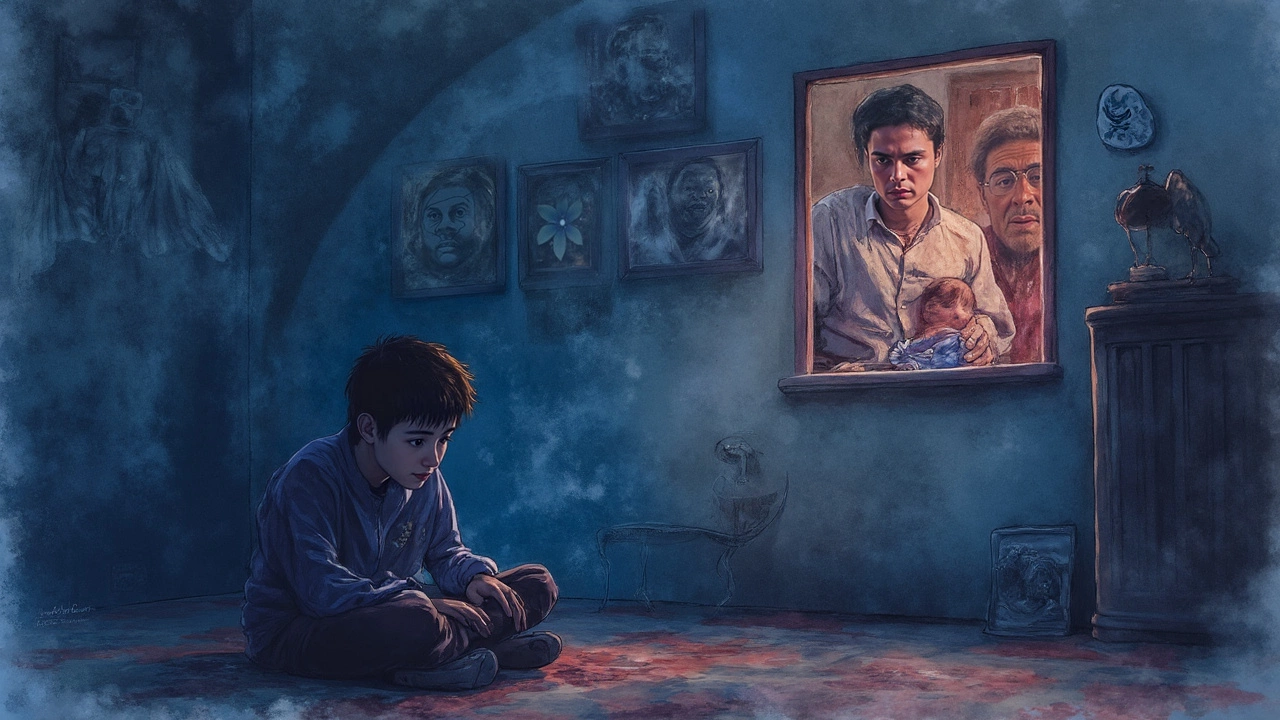
- May, 25 2025
- 0
Imagine not being able to trust your own mind. That’s what makes some mental illnesses so terrifying—not just a bad mood, but a total breakdown in reality. It’s not like feeling sad or anxious for a day; it can mean hearing voices, seeing things that aren’t there, or having thoughts that spiral out of control.
For a lot of people, the idea of losing track of what’s real is way scarier than anything a horror movie can pull off. Most of us take reality for granted, but psychosis rips that baseline away. And if you think this only happens in movies, think again—millions of folks worldwide get hit by it every year. That’s why understanding what’s really going on here matters so much, especially if someone you know seems off or you’re worried about your own thoughts shifting in weird ways.
- Why Some Mental Illnesses Are So Terrifying
- Living with Psychosis: Everyday Horror Stories
- Schizophrenia vs. Other Scary Disorders
- Finding Help: What Works When It Feels Hopeless
Why Some Mental Illnesses Are So Terrifying
Ever wonder why people seem way more scared of things like psychosis or schizophrenia compared to depression or anxiety? It’s the loss of control and reality that really unsettles people. With some mental illnesses, your very sense of what’s real can go out the window. That’s way scarier than just feeling down or worried.
Here’s what makes these illnesses pop up on everyone’s nightmare list:
- Reality Breaks: Disorders like schizophrenia can cause hallucinations or delusions. When your brain tricks you, it’s hard to know what’s real and what’s not.
- Loss of Self: You might start to feel like you don’t recognize yourself, or like your thoughts no longer belong to you. People who go through psychosis say this is one of the worst parts.
- No "Off Switch": Symptoms can become so strong that people might forget what it felt like to be themselves. Unlike sadness, it can feel like you’re totally cut off from your old life.
- Stigma: Movies and news stories often show people with these illnesses as unpredictable or dangerous, which just adds to the fear and loneliness.
Just how common are these terrifying experiences? Check out this quick snapshot:
| Condition | People Affected in Lifetime (World) | Main Scary Feature |
|---|---|---|
| Schizophrenia | 1 in 300 | Break from reality, hallucinations |
| Bipolar Disorder (with psychosis) | 1 in 100 | Intense mood swings + possible breaks from reality |
| Major Depressive Disorder (with psychotic features) | 1 in 200 | Negative voices, paranoia |
So, if you or someone you know is acting strange, hearing or seeing things that aren’t there, or seems to truly believe things that don’t make sense, it’s not a personality flaw. These illnesses aren’t rare in the bigger picture. And the fear? Most of it really comes from not understanding what’s going on.
Learning more, talking openly about it, and reaching out for help can chip away at that terror. Even the scariest mental illnesses are treatable, especially if caught early.
Living with Psychosis: Everyday Horror Stories
Living with psychosis is like having the rug pulled out from under reality. People often hear voices that aren’t there, or see things that no one else can see. These aren’t just “odd thoughts”—for someone with psychosis, the hallucinations and delusions feel 100% real. One guy shared that every time he left his apartment, he was convinced someone was out to get him. Another person said it felt like the world had turned into a bad dream that she couldn’t wake up from.
If you think stuff like this is rare, here’s a reality check: The World Health Organization notes that about 1 in 300 people around the world live with schizophrenia. That means millions of people deal with these terrifying symptoms—every day. Psychosis doesn’t play favorites. It shows up fast or builds over time, hitting teens, adults, and even older folks.
"People experiencing psychosis often struggle to trust their senses and can feel completely isolated, even when surrounded by loved ones." – Mayo Clinic
The worst part? Many don’t know what’s happening at first. Imagine suddenly hearing a voice talking about you when the room is empty, or feeling absolutely sure someone is spying on you but everyone else says it’s fine. These aren’t just stories; they’re day-to-day life for lots of people.
Getting through daily tasks can feel impossible. Making coffee? Fine, until you start doubting if it’s poisoned. Catching a bus? That’s hard when you believe the passengers are all undercover agents. Some people with psychosis manage to hide it for a while, which only makes the stress worse. Having to act “normal” while your brain is playing tricks is exhausting.
- If you notice a friend suddenly getting paranoid or withdrawn, don’t brush it off.
- If someone confides that they’re seeing things or hearing voices, take it seriously—even if it sounds wild.
- Encourage them to chat with a mental health professional ASAP. Early help can really change the outlook.
Living with psychosis isn’t just scary. It’s isolating, confusing, and can hijack someone’s whole sense of self. But understanding what’s actually happening makes it less mysterious and a bit less terrifying—for everyone.

Schizophrenia vs. Other Scary Disorders
People always talk about schizophrenia whenever really frightening mental illnesses come up, but why does it top the list? For starters, it totally messes with how you see and think about the world. We’re talking about hallucinations (like hearing voices when no one’s around) and delusions (believing wild things that just aren’t true). It’s not just random; these symptoms are severe and stick around, sometimes making it tough to tell what’s real at all.
Now, a lot of people mix up schizophrenia with other disorders that can look scary—like bipolar disorder (with its intense highs and lows), dissociative identity disorder (multiple personalities), or severe depression with psychotic features. But there’s something different about schizophrenia. It doesn’t just flip your mood or make you see things for a short time; it can hijack your whole sense of reality for months or years if untreated.
Check out how these serious mental illnesses stack up:
| Disorder | Main Symptoms | How Long Symptoms Last | How Common? |
|---|---|---|---|
| Schizophrenia | Hallucinations, delusions, disorganized thinking | 6+ months | About 1% globally |
| Bipolar Disorder | Extreme mood swings, possible psychosis during mania/depression | Weeks to months (episodes) | 2-3% globally |
| Dissociative Identity Disorder | Two or more distinct identities, memory gaps | Months to years | Est. 1% (rare, controversial diagnosis) |
| Major Depression (with psychosis) | Deep sadness, hopelessness, occasional hallucinations/delusions | Usually weeks to months | About 5% globally for major depression |
What makes psychosis in schizophrenia stand out is how it messes with everyday life. Someone might stop showing up at work, avoid friends, or become convinced of things that just aren’t happening. Compared to mood disorders, which usually have ups and downs, schizophrenia often drops people into confusion and fear for long stretches. That’s why so many see it as the most terrifying.
But here’s the thing: these other disorders can still feel absolutely brutal, especially if someone has no idea what’s happening or where to even start looking for help. The main difference is how much reality seems to slip away—and how long it sticks around if you don’t get treatment.
Finding Help: What Works When It Feels Hopeless
Everything can feel pointless when you’re stuck inside something like psychosis. But here’s the thing—it’s not a lost cause. People get better. Maybe not overnight, but with the right steps, things can get more manageable. The first move? Reach out to someone, even if it's just a text to a friend or a hotline. Nobody should tackle this stuff alone.
Therapy works. Cognitive behavioral therapy (CBT) has been tested over and over, especially for psychosis and schizophrenia, and studies say it can lower scary symptoms when paired with meds. Speaking of meds, antipsychotics are the top choice for most doctors. They don’t "fix" everything, but they help slow down the wildest symptoms, and that can make all the difference. Here’s a quick look at what helps, based on what works for most people:
- Cognitive behavioral therapy (CBT), especially from therapists trained in psychosis
- Consistent use of antipsychotic medication under a doctor’s guidance
- Family support—it really matters, since isolation makes symptoms worse
- Peer support groups, both in-person and online, for sharing real stories
- Good sleep, since even a couple of bad nights can trigger symptoms
If you want to see how effective these things can be, check out the data below. This table sums up what researchers found about major treatments for psychosis:
| Treatment | % of People Who See Improvement | Best For |
|---|---|---|
| Antipsychotic medication | About 70% | Reducing delusions/hallucinations |
| Cognitive Behavioral Therapy (CBT) | 55-60% | Managing thoughts, daily coping |
| Family/peer support | 50%+ | Keeping recovery on track |
One more tip—never ditch your meds or therapy just because you’re having a good day. Relapses can hit hard and fast. Make small goals, track your progress (even with a notebook), and don’t be afraid to ask for help. If things ever feel too intense or unsafe, call a crisis line or go to the ER. It sounds extreme, but safety comes first.
No matter how rough it gets, there’s real hope. Recovery isn’t about "going back to normal"—it’s about building a life that still feels worth living, even on the tough days.
Nikhil Verma
I'm a dedicated physician with a passion for exploring the intricacies of medicine, focusing on the unique healthcare challenges in India. I spend much of my spare time writing articles aimed at improving public understanding of health issues. Balancing my clinical practice and writing allows me to reach a wider audience, sharing insights and fostering a deeper appreciation for medical advancements. I derive immense satisfaction from both treating patients and engaging with readers through my writing.